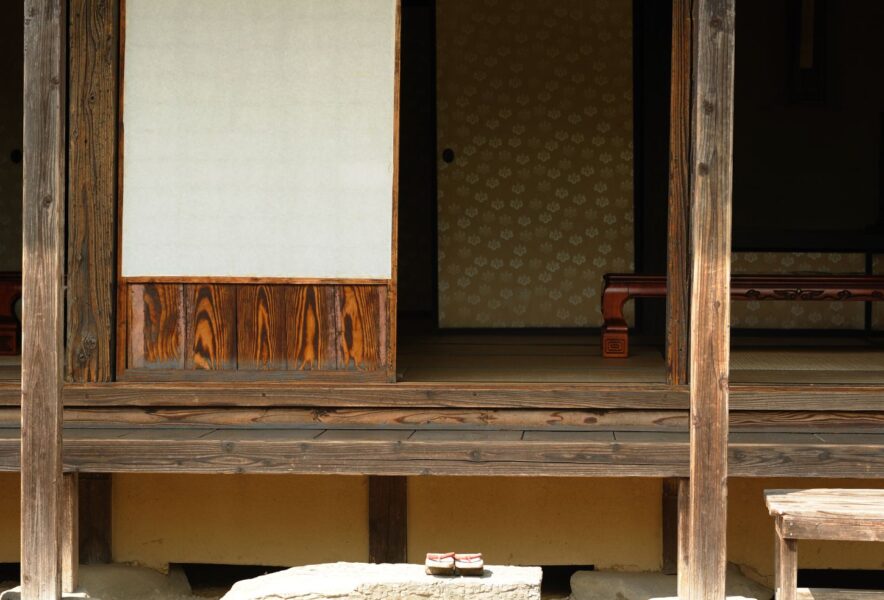When you visit Japan, you’ll frequently encounter the custom of removing shoes at various places—at entrances, in traditional inns, at restaurants, and even at temples. This practice is deeply rooted in Japanese culture and daily life. In this article, we’ll explore the background of this unique custom and how you can enjoy and appreciate it during your travels.
The Origins of the Shoe-Removing Custom
The tradition of removing shoes before entering a house in Japan dates back centuries. Traditional Japanese homes had tatami mats and wooden floors, and stepping inside with outdoor shoes would bring in dirt and grime, dirtying these surfaces. This practical consideration led to the custom of removing shoes at the entrance.
Additionally, many traditional Japanese homes had a “tokonoma,” a sacred space where items such as family altars or decorative flowers were placed. To keep these spaces clean and show respect, removing shoes before entering the home became a standard practice. This tradition has been passed down through generations and remains a fundamental aspect of Japanese life today.
The Importance of Cleanliness in Japan
In Japan, cleanliness is of utmost importance. The humid climate in Japan makes homes more susceptible to mold and bacteria if dirt is brought inside. Therefore, removing shoes at the entrance plays a crucial role in maintaining a clean and healthy living environment.
By leaving shoes at the door, Japanese people can ensure that their homes remain clean and comfortable for both family members and guests. This practice isn’t just about keeping dirt out; it’s also about creating a clear boundary between the outside world and the home, reinforcing the idea that the home is a special, restful place.
The Japanese Concept of “Home”
For Japanese people, a home is more than just a place to live—it’s a sanctuary for both the mind and body. The home is seen as a space to relax, recharge, and escape the stresses of daily life. To maintain this sanctuary, keeping the home clean and comfortable is essential.
Removing shoes at the door helps to maintain a special atmosphere within the home, free from the dirt and stress of the outside world. Whether it’s lounging on tatami mats or simply walking barefoot, this practice enhances the sense of relaxation that Japanese homes are known for.
Removing Shoes as a Sign of Respect
Removing shoes is also a key part of Japanese etiquette. When visiting someone’s home, taking off your shoes and neatly placing them at the entrance shows respect and gratitude to the host. It’s a small gesture that signifies that you value and care for the cleanliness of their home.
Even in public places, removing shoes is sometimes required as a sign of respect for the sanctity or special significance of the space. For example, in tea rooms or temples, removing shoes is a way of purifying yourself before entering a sacred or revered area.
Where You’ll Encounter Shoe-Removing in Japan: Inns, Restaurants, and Temples
As you travel around Japan, you’ll find yourself removing your shoes in various settings. For instance, at traditional inns (ryokan) and guesthouses, it’s customary to take off your shoes at the entrance. This is often required not just when entering the room, but also when moving around the inn, especially in areas with tatami mats or when heading to the onsen (hot spring).
Similarly, many restaurants in Japan, especially those with sunken kotatsu tables or tatami seating, will ask you to remove your shoes before entering. While this might feel unfamiliar at first, it allows you to fully relax and enjoy your meal in a way that is uniquely Japanese.
Temples and shrines are also places where you’ll often be asked to remove your shoes. When entering temple buildings or visiting special rooms like tea houses, removing your shoes is a sign of respect for the sacred nature of the space. It’s a simple act that connects you to the deep traditions and cultural values of Japan.
Conclusion: Embrace Japanese Culture by Removing Your Shoes
The custom of removing shoes in Japan is more than just about cleanliness—it’s deeply intertwined with the values of respect, hospitality, and creating a serene living space. As you explore Japan, embrace this cultural practice, and you’ll gain a deeper understanding of what makes Japanese homes and special places so unique.
At first, you might find it a bit unusual, but by participating in this practice, you’ll experience the comfort and cleanliness that are central to Japanese life. It’s a simple yet profound way to connect with Japan’s rich cultural heritage and make your trip even more memorable.

Comment